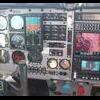I have 100 hours since our major avionics upgrade including the Aspen. I mated it to a Garmin 430 WAAS and GMX 200. Also installed a JPI. Since we do long IFR legs in the Western states, I chose to leave the key legacy instruments in the aircraft as backup. Also, choose to not relocate A/I and HSI as I wanted to be able to rely on my habitual IFR scan in case of trouble with the new avionics. While I have not had any problems with the install or new boxes at all, I am glad I kept two of the most important instruments in their usual places.
The Aspen is a great addition to serious IFR work. The GPSS automatic turns at waypoints on the flight plan make IFR workload easier especially while solid IMC and staying ahead of bumps and ice. The air data computer information for wind speeds and direction was one of the reasons I opted for this unit. That information is very helpful when flying in the 15,000 to 18,000 altitudes where we find ourselves most often. While the aural warning on altitude deviation is a promised upgrade to the unit that will be welcomed, the current visual warning on the box is quite effective. Also, the heading bug for autopilot operation when not in GPSS mode is very simple and quick to orient even in bumpy clouds.
In my view, the GMX 200 is one of the most important tools for serious IFR work. Especially when flying over some of the vast expanses of the West. Added to the other panel upgrades as well as Monroy long range fuel that we installed at about the same time as the panel upgrade, we have a very capable long range flyer.

